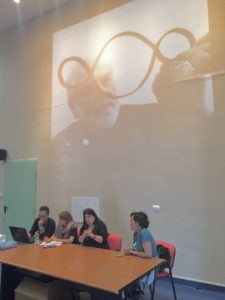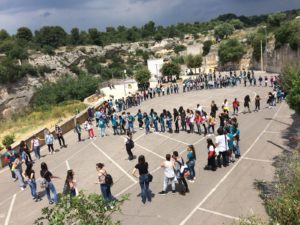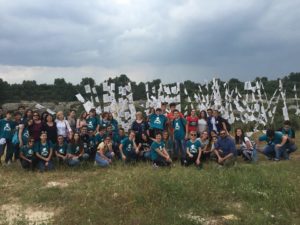Turning art into an instrument of reflection on the respect of nature and the territories we live in, this is the objective of GravInArte, the artistic residency dedicated to land art held in Terra delle Gravine (literally: the land of ravines), in Massafra. The town in the province of Taranto has in fact hosted a round table called and centred on the theme of “Contemporary art as a paradigm of resilience and regeneration of the territories” and a Third Paradise performance curated by Cristina Pistoletto and Stefania Crobe. The initiative, dedicated to Michelangelo Pistoletto’s sign-symbol, was carried out by the Institute De Ruggieri (artistic and scientific high school) and the Secondary School Manzoni in Taranto. GravInArte is an event promoted and organized by the association Salento Slow Travel – in collaboration with Are_Lab and the association Il Serraglio – part of Gravina in Action, a project co-financed by the Presidency of the Council of Ministers, Youth and National Civil Service Department, with the call “Youths for the promotion of the public heritage”, aiming at trying out a strategy of ecosustainable tourist promotion of Gravina della Madonna della Scala in Massafra.


“The works – we read in a press release – well display their artistic and natural interpenetration with the ravine, appearing as a harmonic whole. Art and its thousand facets can lead to the regeneration of a territory. This is – in a nutshell – the consideration emerged in the course of the round table held in the splendid context of Masseria Amastuola, a concept agreed upon by Christian Caliandro, Stefania Crobe, Cristina Pistoletto and Alessandro Bulgini, as well as the two winners of the artistic residency, and supported by their personal experiences and skills. Contemporary art can perfectly combine with the peculiar territory of Terra delle Gravine, enhancing the natural features of this rural landscape where material and immaterial cultures coexist. That’s why the collaboration of all the actors inhabiting these places – not only students and citizens, but also institutions – is very important, so that participation and sharing facilitate the pursuing of the environmental safeguard essential for the sustainability of these territories”.

“It’s been very interesting to meet, through GravInArte, so many inquiring and attentive youths from local schools and sensitive teachers able to convey passion and culture. – says Cristina Pistoletto – Together, we presented the Third Paradise and discussed the implications of the sign. We also talked about possible ways to act in the awareness of the present contrast between nature and artifice, and the responsibilities we have to assume not to let artifice destroy nature. We asked students to write, draw or trace a sign, even a single word, which described their suggestion of a third option, the one to inscribe – as an act – in accordance with the mediating and responsible meaning of the symbol’s central circle. The results were interesting, the students extremely involved. We then physically formed a Third Paradise with the young participants (over 150) right in front of the ravines, to honour them and commit to caring for the territory starting from the symbology of art. It was basically a playful moment, but it embodied the attention we can focus on situations, places and territories through art. Art conveys a desirable synthesis between opposites, not only between nature and artifice, but in any possible conflict of terms and realities, considering a specific defining third option”.
The 4 winning works, which were installed in the ravine a few days ago, are:‘Avvolgimento’ by Lucia Marchesin; ‘Finestre sul futuro’ by Vera Belikova; ‘Grimorio al vento’ by the high school students; ‘Mater Scalae’ by the student Mariagrazia Carpignano.

